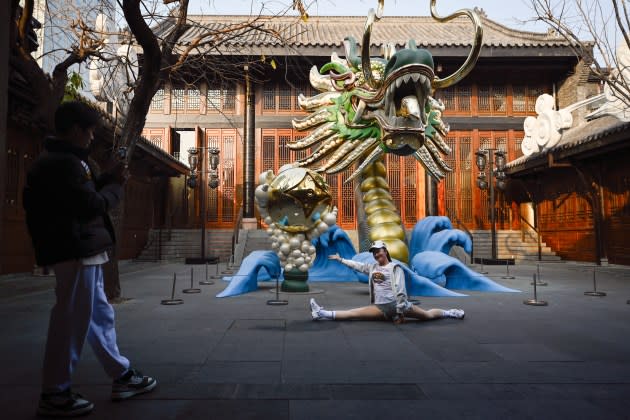China’s Lunar New Year Spending Surpasses Pre-COVID-19 Levels

A Lunar New Year spending boom offers glimmers of hope for China‘s retail outlook for 2024.
According to the latest official data, domestic travel and spending saw significant increases from 2019; however, this year’s holiday was one day longer than that of 2019.
More from WWD
During this year’s eight-day holiday, 474 million trips were made domestically, up 19 percent compared to 2019; holiday spending reached 632.69 billion renminbi, or $87.9 billion, a 7.7 percent increase compared to 2019.
Despite a flight shortage that left some travelers stranded in Hainan, the duty-free paradise remained a popular destination during the holiday.
According to data from Haikou customs, 2.49 billion renminbi, or $345.8 million, worth of duty-free goods were sold on the island during the Lunar New Year, with an average ticket value of 8,358 renminbi, or $1,161, spent at retail outlets, representing an increase of 60 percent year-over-year.
The number of mainland travelers to Hong Kong exceeded 1.25 million this year, surpassing 2019 levels, according to local officials. However, many of these have become money-pinching day trips focused on sightseeing rather than splurging on luxury goods, according to local media reports.
Outbound tourism still needs more time to recover. Based on travel platform Fliggy’s analysis, international bookings quadrupled compared to the same period in 2023, but only recovered to a little more than 50 percent of 2019 levels. Around 3.6 million mainland Chinese tourists traveled abroad this year, with South East Asian countries being the most popular destinations, according to official data.
Based on Global Blue’s January data, in the European market, Chinese luxury spending remains 20 percent below pre-COVID-19 levels.
“[Chinese tourism spending in Europe] is likely to remain lackluster in 2024 in the absence of group tours,” said a recent HSBC report, citing a European Travel Commission report that listed mainland China as “the only market witnessing a significant decrease in the number of individuals planning long-distance travel in 2024.”
“This is mainly on account of higher travel costs and limited vacation time,” wrote HSBC. Based on the official calendar, Labor Day in May and National Day in October, which grants five and seven days of rest, are the two public holidays that allow Chinese tourists to travel long haul for the remainder of the year.
As thousands of Chinese — 2.29 billion, to be exact — flock back to their hometowns during the February holiday, online interest in lower-tiered cities spurred a consumption frenzy.
According to Douyin, the Chinese version of TikTok, 7.8 million short videos related to small-town retail scenes helped boost online consumption sales by 1.18 billion renminbi, or $163.9 million.
For luxury players, holiday-themed window displays, dragon-adorned products and customized WeChat red packet designs have become tried-and-true tactics that can help brands gain visibility during the critical holiday season.
But anecdotal evidence suggests that luxury players are facing a bumpy road ahead due to broader economic concerns. During the pre-Lunar New Year shopping period, Bernstein observed a nearly 50 percent footfall decline at Shanghai’s key luxury retail malls, including Plaza 66 and IFC. By counting the number of shoppers inside and lining outside the stores, Bernstein ranked Chanel, Louis Vuitton, Moncler, Dior and Celine as the top five brands in terms of footfall.
“The top three brands by traffic, namely Chanel, Vuitton and Moncler, accounted for 50 percent of total footfall, up from 35 percent of total footfall in 2023,” the Bernstein report said.
As the February Lunar New Year holiday is a significant gifting occasion, precious jewelry sales also fared well. But based on Bernstein’s tracking, Tiffany & Co. was the only jewelry brand to see footfall increase year-over-year at the two surveyed malls.
As Chinese consumers tend to invest in gold jewelry for good luck and prosperity during Lunar New Year, sales of gold, silver and jewelry increased over 10 percent year-over-year during Lunar New Year, according to data from the Ministry of Commerce.
Based on a new study from RTG, despite the property downturn and job woes, China’s consumer confidence remains resilient.
Based on RTG’s survey in key cities of 1,000 Chinese consumers ages 18 to 25, more than 67 percent of the respondents expressed optimism in the future. Forty-three percent of those polled expressed an intention to make luxury purchases in the first half of 2024.
“New first-tier cities in China, especially Chengdu, stands out in this trend. Its rapid development as a luxury hub saw many luxury brand pop-ups over the years,” said the RTG report.
But CICC Research, China’s third-largest investment bank, said this year’s holiday retail resurgence reflects “an uneven recovery of post-pandemic consumption.”
“Chinese citizens are willing to spend, but their pockets are not ready. Without enough effective demand, citizens are more prone to hold back on spending until the next holiday time slot,” explained CICC.
“Future consumption may continue to improve, but it still depends on what will truly drive recovery momentum. Thus, one must pay attention to policy implementation that can help stabilize growth,” CICC explained.
Best of WWD

